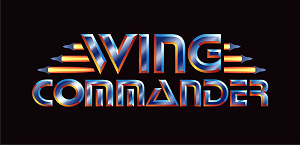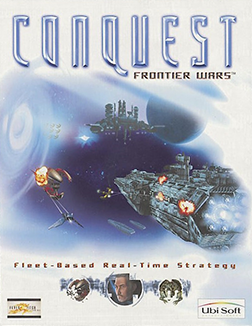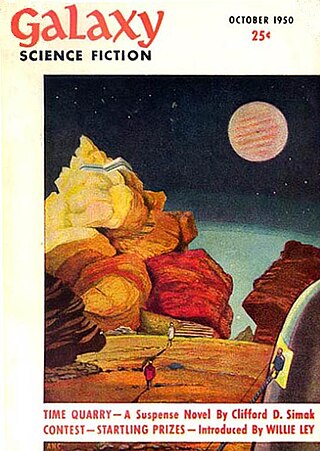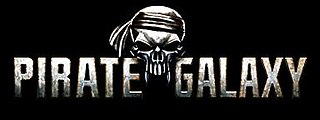
Descent: FreeSpace – The Great War, known as Conflict: FreeSpace – The Great War in Europe, is a 1998 space combat simulation IBM PC compatible computer game developed by Volition, when it was split off from Parallax Software, and published by Interplay Productions. In 2001, it was ported to the Amiga platform as FreeSpace: The Great War by Hyperion Entertainment. The game places players in the role of a human pilot, who operates in several classes of starfighter and combats against opposing forces, either human or alien, in various space-faring environments, such as in orbit above a planet or within an asteroid belt. The story of the game's single player campaign focuses on a war in the 24th century between two factions, one human and the other alien, that is interrupted in its fourteenth year by the arrival of an enigmatic and militant alien race, whose genocidal advance forces the two sides into a ceasefire in order to work together to halt the threat.

Wing Commander is a media franchise consisting of space combat simulation video games from Origin Systems, Inc., an animated television series, a feature film, a collectible card game, a series of novels, and action figures. The franchise originated in 1990 with the release of video game Wing Commander.
Orion's Arm is a multi-authored online science fiction world-building project, first established in 2000 by M. Alan Kazlev, Donna Malcolm Hirsekorn, Bernd Helfert and Anders Sandberg and further co-authored by many people since. Anyone can contribute articles, stories, artwork, or music to the website. A large mailing list exists, in which members debate aspects of the world they are creating, discussing additions, modifications, issues arising, and work to be done.

Vendetta Online is a twitch-based, science fiction massively multiplayer online role-playing game (MMORPG) developed by Guild Software for the operating systems Android, Linux, Mac OS X, iOS, and Microsoft Windows. It uses the NAOS game engine, a fully real-time flight model and combat system, to offer first-person/third-person shooter-style player versus player and player versus environment battle action against the backdrop of a massively multiplayer universe. Vendetta Online shipped as a commercial MMORPG on November 1, 2004 with a subscription-based business model, although it has been running continuously since April 2002. Vendetta Online is available to play across a wide array of platforms, including the Oculus Rift virtual reality display, allowing all users to directly interact in a single, contiguous galaxy. It is also notable for its twitch combat and fidelity to real physics.
"Crossover" is the 43rd episode of the science fiction television series Star Trek: Deep Space Nine, and the 23rd episode of the second season. This episode was written by Peter Allan Fields and Michael Pillar, and directed by David Livingston. It aired on broadcast television on May 16, 1994.

Conquest: Frontier Wars is a real-time strategy game released in 2001 by Ubi Soft and developed by Fever Pitch Studios. A good amount of the development was done at Digital Anvil in Austin, Texas, a startup developer originally owned by Chris Roberts, Erin Roberts, Eric Peterson, John Miles, Tony Zurovec, Marten Davies and Robert Rodriguez. Once Microsoft purchased Digital Anvil, Eric Peterson and Tom Mauer left to form Fever Pitch Studios Inc, and lead a team to complete the game as originally intended by the team. On December 9, 2013, the source code was bundled with every copy of the game purchased on GOG.com.

Sins of a Solar Empire is a 2008 science fiction real-time strategy video game developed by Ironclad Games and published by Stardock Entertainment for Microsoft Windows operating systems. It is a real-time strategy (RTS) game that incorporates some elements from 4X games; its makers describe it as "RT4X". Players are given control of a spacefaring empire in the distant future, and are tasked with conquering star systems using military, economic and diplomatic means.

DarkStar One is a space trading and combat simulator game developed by German studio Ascaron and published by CDV.

The planetary systems of stars other than the Sun and the Solar System are a staple element in many works of the science fiction genre.

Star Command: Revolution is a real-time strategy game developed by Metropolis Digital, Inc. and published by GT Interactive. It was originally released in 1997 for MS-DOS, and was re-released in 1998 for Microsoft Windows under the title Star Command Deluxe. This re-release was overshadowed by its contemporary, Starcraft. A sequel, Star Command X: Armada, is hinted at upon successful completion of the campaign mode, but it was never produced. Instead, the developer released the similarly named but unrelated game Armada on November 26, 1999.

X3: Terran Conflict is a space trading and combat simulator by German developer Egosoft, part of their X series of games. Described as a stand-alone game, based on X3: Reunion, it boasts new plot lines, features and assets. It was first released in October 2008 for the European market and Steam.

Space Empires: Starfury is an action video game developed by Malfador Machinations and published by Shrapnel Games on September 22, 2003. The game is set in a Space Empires universe containing planetary systems linked by warp points, or wormholes. The game allows the player to control a single spaceship to explore the universe.

Deep Space Nine is a fictional space station, the eponymous primary setting of the American science fiction television series Star Trek: Deep Space Nine which aired from 1993 to 1999. It serves as a base for the exploration of the Gamma Quadrant via the Bajoran wormhole and is a hub of trade and travel for the sector's denizens. It is run by a joint crew of Starfleet and Bajoran officers and it is the home port of a number of Starfleet runabouts, as well as the starship USS Defiant.

Pirate Galaxy is a free-to-play, massive multiplayer online game written in Java. Players can operate spaceships, explore a collection of planets, mine minerals, and fight other players and enemies in the planetary combat. The game features 3D graphics and runs from a downloadable client.
Space Pirates and Zombies (S.P.A.Z.) is a real-time strategy video game released on August 15, 2011, on the Steam distribution platform. with a top-down perspective based around space combat. The game was developed by a two-man team under the studio MinMax Games using the Torque engine. The game was later ported for Mac OS X and Linux systems.

Starpoint Gemini 2 is a space trading and combat simulator developed by the Croatian-based Little Green Men Games development studio. It is a direct sequel to Starpoint Gemini, which was released in 2010.

Hyper Void is a 3D shooter video game, developed and published by InFramez Technology. It was released for PlayStation 3, PlayStation 4, Xbox One and Microsoft Windows.

Armor Command is a military science fiction real-time strategy video game developed by American studio Ronin Entertainment and published by Ripcord Games for Windows in 1998. Set in the early 30th century, the game revolves around two factions, the United Terran Federation led by humanity, and the Vrass, a feudal slaver empire led by aliens. Armor Command was designed by Edward Kilham, known as the co-designer of Star Wars: TIE Fighter. Armor Command released to generally positive and lukewarm reviews, although seen as obscure in comparison to more notable games in the genre.














